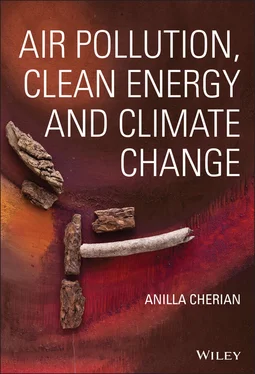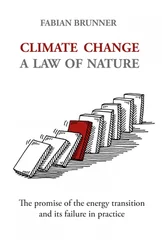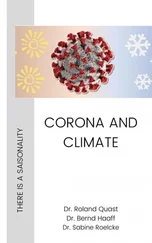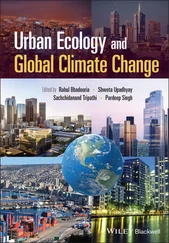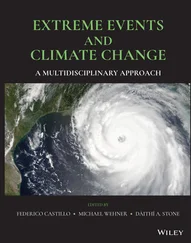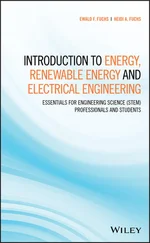Anilla Cherian - Air Pollution, Clean Energy and Climate Change
Здесь есть возможность читать онлайн «Anilla Cherian - Air Pollution, Clean Energy and Climate Change» — ознакомительный отрывок электронной книги совершенно бесплатно, а после прочтения отрывка купить полную версию. В некоторых случаях можно слушать аудио, скачать через торрент в формате fb2 и присутствует краткое содержание. Жанр: unrecognised, на английском языке. Описание произведения, (предисловие) а так же отзывы посетителей доступны на портале библиотеки ЛибКат.
- Название:Air Pollution, Clean Energy and Climate Change
- Автор:
- Жанр:
- Год:неизвестен
- ISBN:нет данных
- Рейтинг книги:5 / 5. Голосов: 1
-
Избранное:Добавить в избранное
- Отзывы:
-
Ваша оценка:
- 100
- 1
- 2
- 3
- 4
- 5
Air Pollution, Clean Energy and Climate Change: краткое содержание, описание и аннотация
Предлагаем к чтению аннотацию, описание, краткое содержание или предисловие (зависит от того, что написал сам автор книги «Air Pollution, Clean Energy and Climate Change»). Если вы не нашли необходимую информацию о книге — напишите в комментариях, мы постараемся отыскать её.
to leave no one behind
Air Pollution, Clean Energy and Climate Change
Energy and Global Climate Change
Air Pollution, Clean Energy and Climate Change — читать онлайн ознакомительный отрывок
Ниже представлен текст книги, разбитый по страницам. Система сохранения места последней прочитанной страницы, позволяет с удобством читать онлайн бесплатно книгу «Air Pollution, Clean Energy and Climate Change», без необходимости каждый раз заново искать на чём Вы остановились. Поставьте закладку, и сможете в любой момент перейти на страницу, на которой закончили чтение.
Интервал:
Закладка:
Box 1.3Chronic obstructive pulmonary disease: under‐recognition and inequitable impacts on the poor.
‘ COPD remains a growing but neglected global epidemic. It is under‐recognised, under‐diagnosed and under‐treated resulting in millions of people continuing to suffer from this preventable and treatable condition . The lower an individual’s socio‐economic position, the higher their risk of poor health: women and children living in severe poverty have the greatest exposures to HAP.
In the poorest countries, cooking with solid fuels can be the equivalent of smoking two packs of cigarettes a day . A 1‐year old would have accumulated a two pack year smoking history having never seen tobacco. Inaction to mitigate COPD therefore exacerbates health inequalities.
Climbing the “energy ladder” occurs gradually as most LMIC households use a combination of fuels . The poorest, at the bottom of the ladder, use crop waste or dung which is the most harmful when undergoing incomplete combustion. Those at the top of the ladder use electricity or natural gas. Increasing prosperity and development has a direct positive correlation with increasing use of cleaner and more efficient fuels for cooking.
The unmet global burden of COPD is a silent killer in LMICs . In conclusion, we suggest that given the high and rising global burden of COPD, a revolution in the diagnosis and management of COPD and exacerbations of COPD in LMICs must be an urgent priority’.
Source: emphasis added, Quaderi and Hurst (2018).
Box 1.4excerpted from the WHO’s special report on climate change and human health lists key linkages between energy related air pollution, climate change and public health impacts.
Box 1.4Strong linkages between climate change, air pollution and health.
The human activities that are destabilizing the Earth’s climate also contribute directly to ill health.
Burning fossil fuels for power, transport and industry is the main source of the carbon emissions that are driving climate change and a major contributor to health‐damaging air pollution, which every year kills over seven million people due to exposure inside and outside their homes.
Over 90% of the urban population of the world breathes air containing levels of outdoor air pollutants that exceed WHO’s guidelines.
Air pollution inside and outside the home is the second leading cause of deaths from non‐communicable diseases (NCDs) worldwide; it is responsible for 26% of deaths from ischaemic heart disease, 24% of those from strokes, 43% from chronic obstructive pulmonary disease and 29% from lung cancer.
The sectors that produce most GHGs – energy, transport, industry, agriculture, waste management and land use – are also the main sources of fine particulate matter and other important air pollutants. These include short‐lived climate pollutants such as black carbon, methane and ground‐level ozone, which also threaten human health.
Approximately 25% of urban ambient air pollution from fine particulate matter is contributed by traffic, 15% by industrial activities including electricity generation, 20% by domestic fuel burning, 22% from unspecified sources of human origin and 18% from natural sources.
Effectively all exposure to indoor air pollution, which causes almost four million deaths a year, is from use of solid fuels for cooking in poor households.
Source: WHO (2018, p. 16).
What is also significant to underscore is that the health impacts of air pollution are felt disproportionately within poorer communities and particularly amongst women and children from poorer households. The role of gender in determining activities that expose women and young girls to ill health and lack of access to education and employment for instance is important not just in terms of responding to HAP but also in terms of gender‐assigned household responsibilities and hours spent in terms of searching for the very forms of solid fuels that contribute to increased health risks. More than 25 years ago, Indian climate change and energy expert, Jyoti Parikh highlighted the need for greater attention and data collection on gender and energy policy: ‘The fact that there are no gender specific data available in the energy sector‐ which is one of the most quantified sectors is largely due to lack of concern and understanding about gender issues by energy policy makers and analysts’ (1995, p. 7). Parikh pointed out gender‐specific disparities lessen as economic development increases. However, growing health and economic disparities resulting from the COVID pandemic are a major future development concern in terms of gender and racial inequities. Key findings from a special report ‘Burning Opportunity: Clean Household Energy for Health, Sustainable Development, and Well Being of Women and Children’ show that little room for equivocation as to who bears the negative health impacts of exposure to HAP and include the following facts:
‘Household air pollution is the single most important environmental health risk factor worldwide.
Women and children are at a particularly high risk of disease from exposure to HAP. Sixty percent of all premature deaths attributed to household air pollution occur in women and children. Women experience higher personal exposure levels than men, owing to their greater involvement in daily cooking and other domestic activities. The single biggest killer of children aged under five years worldwide is pneumonia. This disease cuts short almost a million young lives each year. More than 50% of those pneumonia deaths are caused by exposure to HAP.
Improving health in urban environments depends in part on addressing pollution from household fuel burning. In India, for example, new research estimates that almost 30% of outdoor air pollution is from household sources.
Women and girls are the primary procurers and users of household energy services, and bear the largest share of the health and other burdens associated with reliance on polluting and inefficient energy systems. Owing to the considerable amount of time spent in proximity to polluting combustion sources, women and children are at particularly high risk of disease from exposure to HAP.
New analyses find that reliance on polluting fuels and technologies is associated with significant drudgery and time loss for children – especially girls. Data on wood and water gathering from 30 countries show that both boys and girls in clean fuel‐using households spent less time gathering wood or water than those from homes cooking mainly with polluting fuels. Girls living in households that cook mainly with polluting fuels bear the greatest time‐loss burden collecting wood or water’ (WHO 2016c, p. ix).
Exposure to air pollution was found to vary greatly by socio‐economic status according to a 2015 review of existing literature on air pollution funded by US National Institute of Environmental Health Sciences. ‘Socioeconomic Disparities and Air Pollution Exposures: A Global Review’ found that poorer communities tend to be exposed to higher concentrations of air pollution, compared to richer communities (Hajat et al. 2015). But there is an additional generational inequity that is being passed on to children from poorer households that was highlighted by the UN Children’s Fund (UNICEF) 2016 report entitled ‘Clear the Air for Children’ . Based on satellite imagery of outdoor air pollution, this report provided for the first time the staggering scale and scope of the air pollution crisis faced by children. South Asia was found to have the largest number of children living with toxic air pollution – 620 million, followed by East Asia and Pacific region – 450 million children; West and Central Africa – 240 million; Eastern and Southern Africa – 200 million, and when taken together all the regions comprised a total of 2 billion children living in areas that exceed WHO guideline limits of 10 μg/m 3(2016, p. 63). Some of the report’s key findings regarding air pollution provide evidence of the costs and disproportionate burdens borne by children in low‐ and middle‐income countries and across regions (see Box 1.5).
Читать дальшеИнтервал:
Закладка:
Похожие книги на «Air Pollution, Clean Energy and Climate Change»
Представляем Вашему вниманию похожие книги на «Air Pollution, Clean Energy and Climate Change» списком для выбора. Мы отобрали схожую по названию и смыслу литературу в надежде предоставить читателям больше вариантов отыскать новые, интересные, ещё непрочитанные произведения.
Обсуждение, отзывы о книге «Air Pollution, Clean Energy and Climate Change» и просто собственные мнения читателей. Оставьте ваши комментарии, напишите, что Вы думаете о произведении, его смысле или главных героях. Укажите что конкретно понравилось, а что нет, и почему Вы так считаете.
